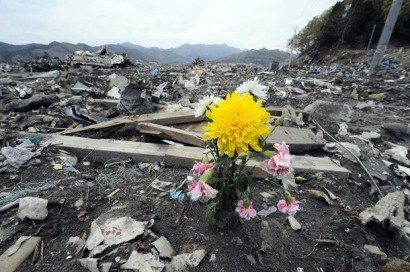
March 2011 was a watershed moment for the clean energy sector as the terrible events unfolding in Japan as a result of the powerful earthquake and tsunami highlighted the risks associated with nuclear energy, and led to the Japanese having to become very inventive when it came to providing its producing and, above all, saving energy.
Our highly prolific blogger, Rick Crume, was soon on the ground in Japan sending us eye-witness accounts of how Japanese ingenuity was getting round the energy crisis, but they came in April. In March, however, we focused our attention on how Japan’s wind and solar industries were coping with life after the tsunami.
Our correspondent, Dan McCue, was one of the first to write about the impact, or lack of it, the tsunami had had on Japanese wind farms. According to Kuga Iwata, Bureau Director of the Secretariat for the Japan Wind Power Association, a few days after the disaster on 11 March, an initial telephone survey of its 119 active member municipalities and companies found all wind power facilities in the nation were still operational. Even the Kamisu semi-offshore wind farm, located about 300 kilometres from the quake’s epicentre survived unscathed.
A couple of days prior to this, Dan had found out that production at Japanese solar module plants had been affected by the disaster, but that most solar arrays were still providing people with much needed power.
The Fukushima nuclear accident actually boosted calls for the uptake of more renewable energy in coming weeks, with European Commissioner in Charge of Climate Action, Connie Hedegaard, signalled at the EWEC 2011 conference last March that European Union (EU) decisions on commissioning new nuclear capacity will be "very much likely to be influenced" by the Fukushima power plant disaster in Japan.
Elsewhere, the Shanghai-based brokerage firm, Shenyin & Wanguo Securities Co., suggested to Bloomberg that China’s wind-power industry may grow faster than market consensus since the Chinese government suspended approval of new nuclear projects following the Japanese disaster.
Meanwhile, our most popular stories in March 2011 were a mixed bunch. Top story with 3,777 hits was an interesting piece on collecting heat from under roads. It looked at how the Construction Unit of the Basque technology centre, Tecnalia, in Spain was participating in the Pavener Project, which aims to develop a system for collecting the solar energy absorbed by asphalt paved surfaces.
Next most read (with 3,605 hits) was another piece on solar energy, but this time looking at the ins and outs Direct Normal Irradiance (DNI) measurements when evaluating solar thermal electric projects. The articles continued a series of top tips for concentrating solar power (CSP) developers by CSP Today.
Technological developments in the offshore wind sector proved popular too last March, as our third top story (3,498 hits) covered Vestas and its plans to perform an R&D project focusing on the deployment of a full-scale semi-submersible floating wind turbine. In doing so, (after a stuttering start) Vestas finally followed the trend set by its competitors such as Siemens, Gamesa, GE, Acciona and Alstom, which had all launched similar projects by then.
Wind turbines also featured in our fourth most read story in March of last year, which received 3,418 hits. It looked at how the Chinese wind turbine manufacturer, Sinovel, had announced plans to roll out a new 6-MW wind turbine to compete with the huge wind turbines being developed by several major European manufacturers. The Danish multinational Vestas, for example, had already announced plans to launch its six-megawatt wind turbine in March. Vesta’s new offering was announced shortly after six and seven-megawatt turbines were unveiled by German companies Enercon, Bard and Multibred-Areva, and Alstom and Gamesa in Spain.
Lastly, our fifth most popular article in March 2011 was on marine energy looking at how tidal energy technologist, Marine Current Turbines Ltd, in partnership with RWE npower renewables, had submitted a consent application to install a 10-MW array of tidal stream turbines off the North West coast of Anglesey (Wales) in 2015.
The other stories making up our top ten included a piece on ABB and how it was investing in concentrating solar power, how the use of enzymes could reduce energy demand of carbon capture by 30%, and Ibiza’s commitment to replacing its old street lighting with the latest LED technology in an effort to save energy.
We also ran a piece on Green Analytics, Inc. from Arkansas (US) with a portfolio of energy efficiency solutions which it claims provide immediate savings on energy costs and Returns on Investment in only three years or less. In an exclusive interview earlier in the same month, the company’s co-founder and CEO, Brandon Fletcher, had explained to Renewable Energy Magazine that the energy saving industry “is missing a voice because it is still trying to figure out what to say”. However, he remained optimistic that this “trillion-dollar market” has a bright future.
Another popular piece looking at the economic benefits of clean energy was an article looking at EurObserv’ER’s latest annual review “The State of Renewable Energies in Europe”. While the data analysed was from 2009, the findings of the report were revealing, showing that EU-27 renewable energy share increased to 11.6% from 10.4% in 2008 and that the sector employed nearly a million people. In his preface to the report, Alain Liébard, President of EurObserv’ER, said he believed 2010 was a year when renewables would come of age, despite new challenges emerging as a result of the global recession.
“The first European directives issued at the beginning of the 2000s set in motion what is now an unstoppable movement. Not only have the renewable sectors arrived, they have become the very cornerstones of national energy and economic policies,” he said.
Nonetheless, the report by EurObserv’ER concluded that despite progress made, more still had to be done to ramp up renewable capacity.
[Inset: Flowers left in rubble after Japanese tsunami. Courtesy of Bruce Sol]
For additional information:

